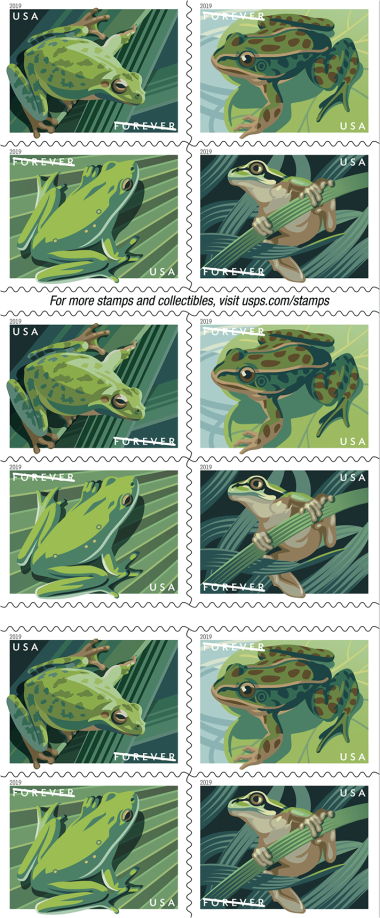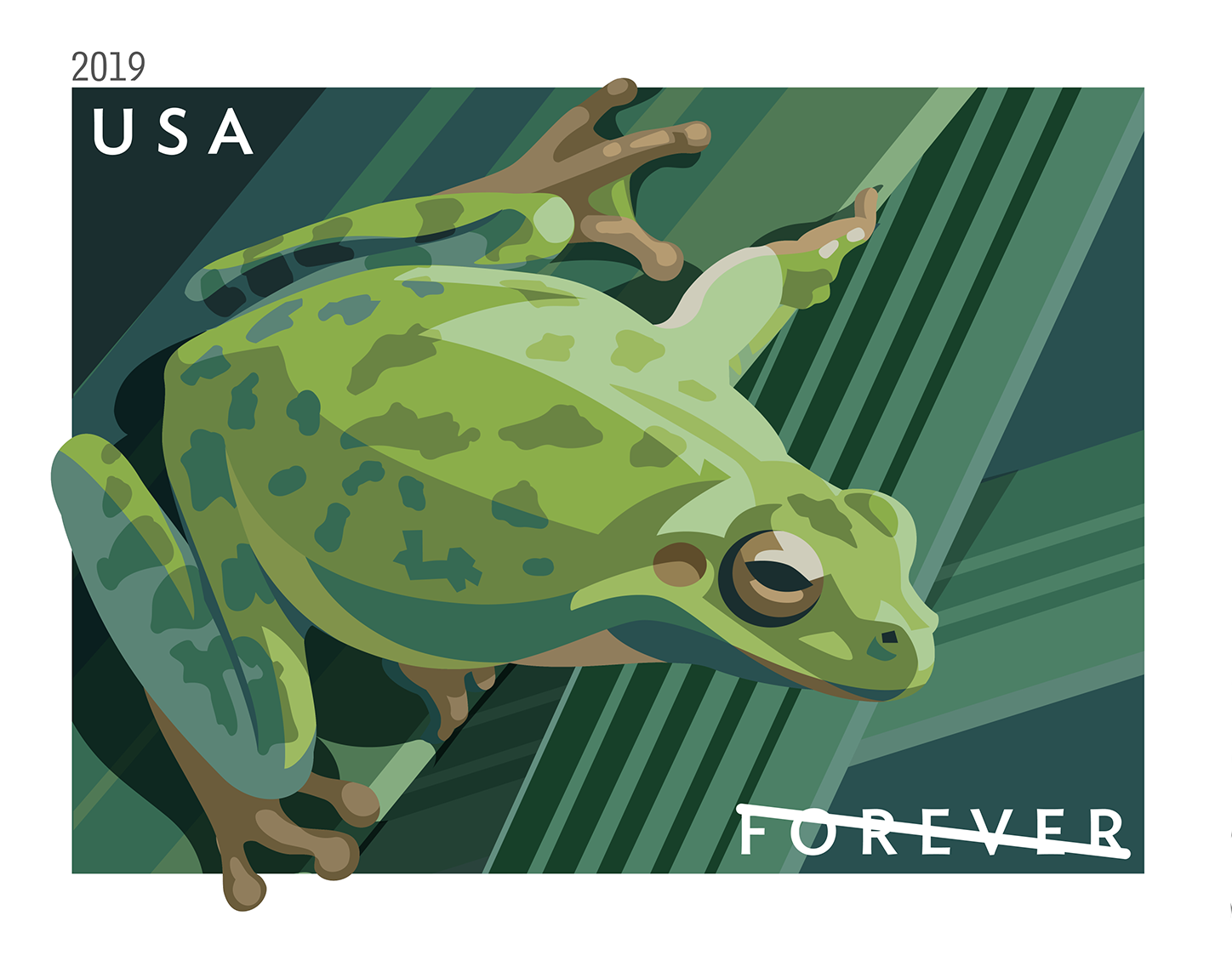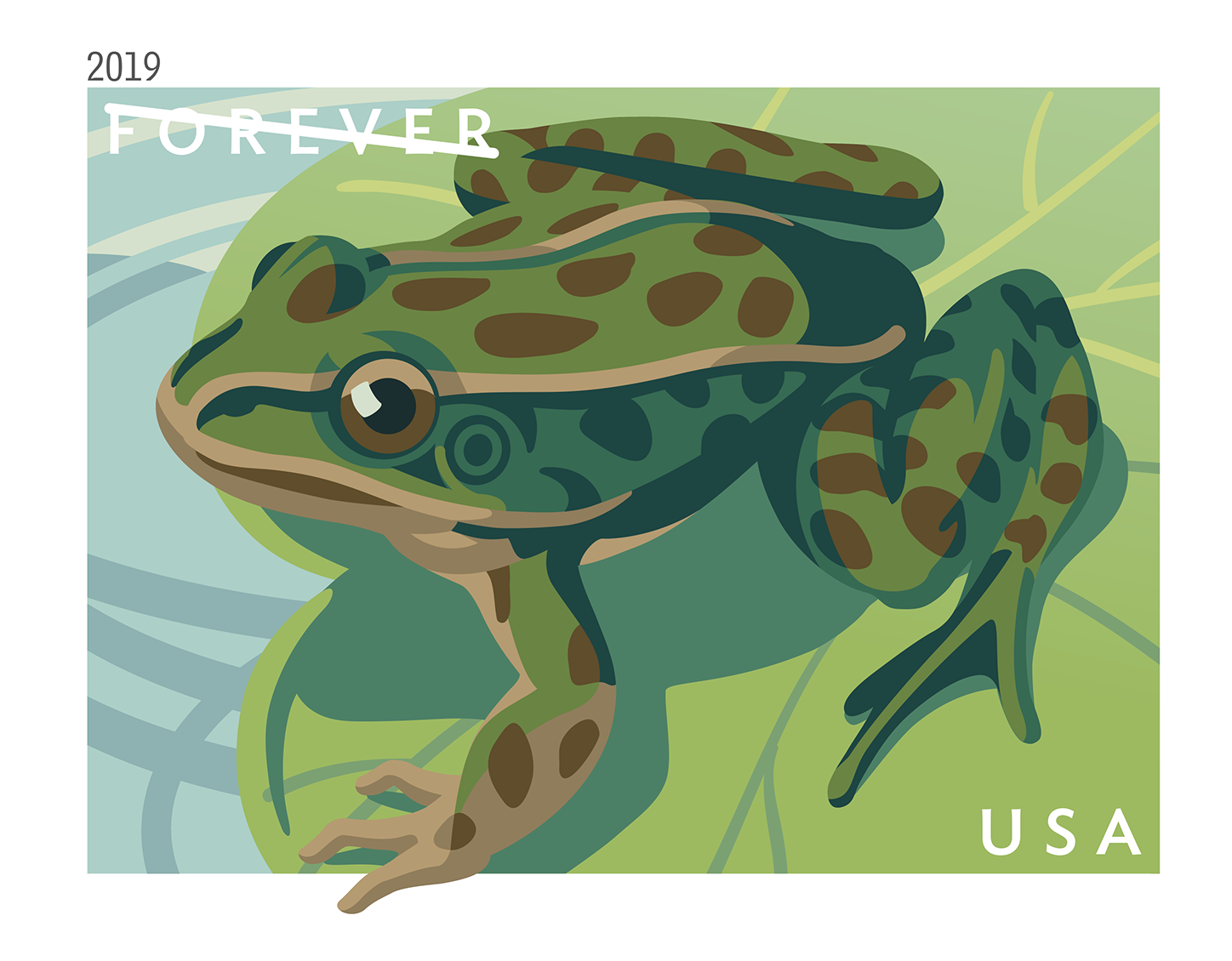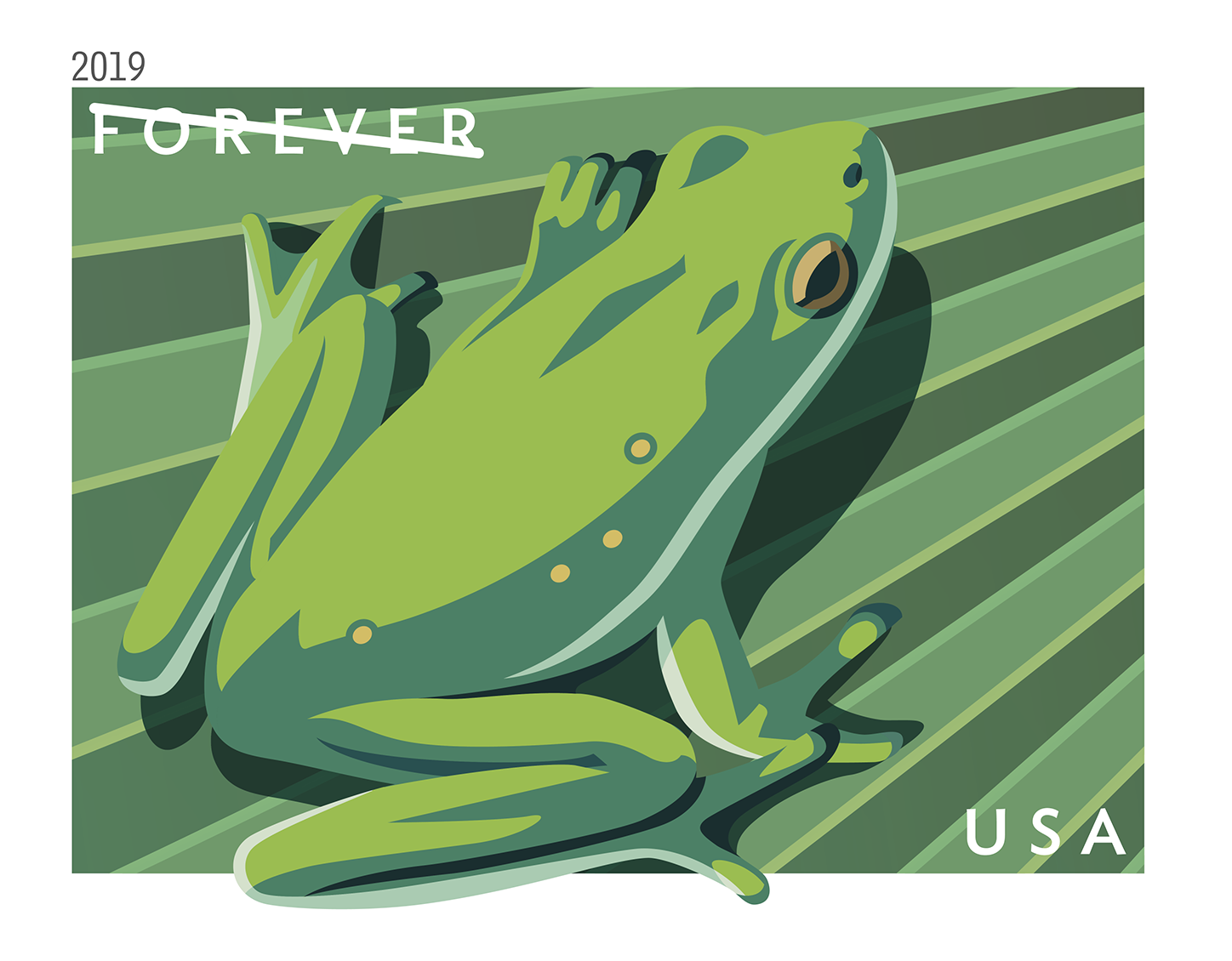
About This Stamp
Numbering more than 4,000 species, frogs live on every continent except Antarctica. Of those thousands, more than 90 species are found in the United States.
Digital illustrations of four North American frogs grace these stamps: the Pacific tree frog, the northern leopard frog, the American green tree frog, and the squirrel tree frog. Working with a primarily green color palette, the artist captured the essence of each animal with enough important defining features to make each recognizable. The subtle changes to the many green tones — with minimal details including spots, underbelly, and toes in shades of brown — accentuate the differences among the four frogs.
Found throughout the western United States, the Pacific tree frog or Pacific chorus frog (Pseudacris regilla) grows no larger than two inches in length and may be one of the world’s most widely heard frogs. Nicknamed the “Hollywood frog,” its calls — rib-bit, rib-bit — have been recorded for use as background noise for nighttime scenes in countless television shows and movies, even those set far from the frog’s actual range.
Growing to an adult size of between two and five inches in length, the northern leopard frog (Rana pipiens) can be found across the northern United States and as far south as New Mexico. Varying in color from green to tan with a light underbelly and light borders that sometimes appear around its spots, this frog is most commonly identified by its highly distinctive call, a rattle-like snoring noise that can last three seconds or longer, followed by several notes described as “chuckling” or “clucking.”
Typically bright green, the American green tree frog (Hyla cinerea) grows to be no larger than two and a half inches long. Known to live as far north as Delaware and Illinois, this frog can be found in ponds, lakes, and swamps throughout the southeastern United States and along the Gulf Coast, where its call is one of the most distinctive in its range. Because the American green tree frog forms large choruses after warm rains, it is sometimes called the rain frog, but others have dubbed it the cowbell frog based on the sound of its short call when heard from a distance.
Found from southeastern Virginia down through Florida and west along the Gulf Coast to Texas, the squirrel tree frog (Hyla squirella) earns its name from a raspy, quack-like call that resembles the scolding noise of a gray squirrel. Its coloring varies greatly from brown to rich green. Growing no larger than one and five-eighths of an inch long, this little frog is often spotted when it hunts for insects at night among patio lights. On summer evenings, large choruses of squirrel tree frogs form in pools and roadside ditches.
Though widespread, some frog populations are vulnerable. In the U.S., amphibians have seen annual declines that, if unchecked, could lead to high-risk populations vanishing in less than a decade. There is positive news for amphibians worldwide, however. Scientists studying amphibians have re-discovered a number of species that were believed to be lost, and species never before seen are being newly identified. Conservation organizations are working, through breeding programs and other efforts, to protect threatened amphibians and rebuild their populations in the wild.
Art director William J. Gicker designed the stamps with original digital art by Nancy Stahl.
Frogs are issued as Forever® stamps. These Forever stamps will always be equal in value to the current First-Class Mail® one-ounce price.
Stamp Art Director, Stamp Designer

William Gicker
William Gicker served as Director of Stamp Services for the U.S. Postal Service from 2020 until his retirement in 2023. In that position he oversaw stamp development, stamp products and exhibitions, stamp manufacturing, stamp fulfillment, and the Postmaster General’s Citizens’ Stamp Advisory Committee (CSAC).
Gicker began working for the U.S. Postal Service in 1998. Initially assistant editor of USA Philatelic, the quarterly stamp catalog produced by Stamp Services, he soon became editor where he oversaw the catalog’s award-winning program until 2013.
Named creative director of stamps in 2001, Gicker became manager and creative director of Stamp Development in 2015. Working closely with Postal Service art directors and CSAC, he managed the creative development and quality control of more than 800 stamp issuances and 1,700 individual stamp designs.
He has served as art director for some of the most popular stamps issued by the Postal Service: the five-year Art of Disney series; Star Wars; Holy Family; Harry Potter; and Hot Wheels. As both art director and designer, Gicker lists among his many stamps, Holiday Baubles; the first international rate Global stamp in 2013; and the Gifts of Friendship joint issuance with Japan. He was also art director for the first stamp to celebrate Diwali, eight more Global Forever® stamps, and several Christmas Madonna and Child issuances, the most recent in 2024.
A native of Pennsylvania, Gicker graduated from West Chester University with a bachelor of arts degree in English Literature. He and his family live in Washington, DC.
Typographer

Greg Breeding
Greg Breeding is a graphic designer and principal of Journey Group, a design company he co-founded in 1992, located in Charlottesville, Virginia. He was creative director until 2013, at which time he began serving as president and continued in that role through 2023.
Breeding’s fascination with modernism began while studying design at Virginia Commonwealth University. His affinity with the movement continues and motivates his ongoing advanced studies at the Basel School of Design in Switzerland most every summer.
As an art director for postage stamp design since 2012, Breeding has designed more than 100 stamps covering a diverse array of subjects, from Star Wars droids and Batman to Harlem Renaissance writers and the transcontinental railroad.
His work has been recognized in annual design competitions held by Graphis, AIGA, PRINT magazine, and Communication Arts.
Breeding lives in North Garden, Virginia, with his wife and enjoys nothing so much as frolicking on the floor with his grandchildren.
Stamp Artist

Nancy Stahl
A native of Long Island, New York, Nancy Stahl studied art at the University of Arizona, the Art Center College of Design in Los Angeles, and the School of Visual Arts in New York City. Her career can be split nearly equally between traditional media and digitally created art. Originally working in graphite, she experimented with a variety of media before making gouache paintings her signature style. She learned to work digitally starting in 1989 and abandoned her paints a few years later.
Stahl’s clients have ranged from newspapers and magazines such as The New York Times, The Wall Street Journal, TIME magazine, and Der Spiegel to corporate identity, packaging and billboards for companies such as The Disney Family Museum, Sharffen Berger chocolates, and Stonyfield Farms. Her love of craft has allowed Stahl to accept assignments as varied as creating lace for the Metropolitan Museum of Art’s Costume Institute and knitting Christmas stamp designs in 2005 for the US Postal Service.
Her work is represented in The Illustrator in America, 1860–2000 by Walt Reed and Rolling Stone: The Illustrated Portraits edited by Fred Woodward. An instructor in the Independent Study Masters Degree program at Syracuse University, Stahl has also taught illustration at the School of Visual Arts and the Fashion Institute of Technology. In 2012, She was elected to the Society of Illustrators Hall of Fame.
Stahl works from her studio in New York City where in her leisure time she pursues her hobby of computerized knitting.
She has designed more than 40 stamps for the U.S. Postal Service including the New York Public Library Lion (2000), three stamps for the Stars and Stripes issuance (2015), 19th Amendment: Women Vote (2020), and Women's Rowing (2022). Stahl is especially well known for her highly stylized animal stamps, including Bighorn Sheep (2007); the Save Vanishing Species semipostal (2011, reissue 2014), featuring a portrait of an Amur tiger cub; Penguins (2015); Frogs (2019); and Save Manatees (2024). Most recently, Stahl illustrated the 2026 Sunflowers stamp.



